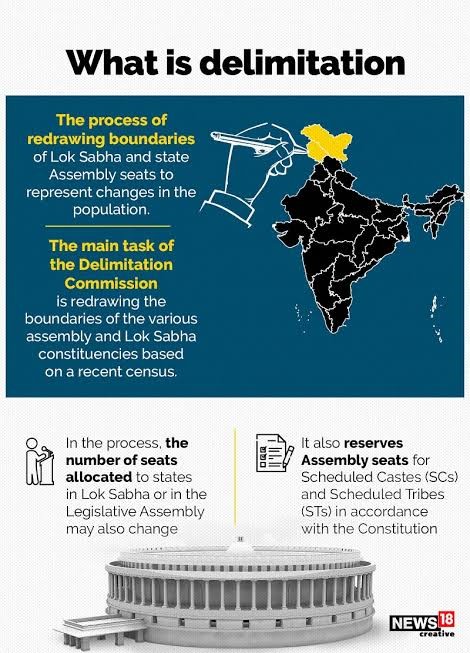A CASE FOR A FAIR SEAT ALLOCATION
Syllabus:
GS-2:
- Đelimitation Commission
- Constitutional machinery
- Census
Why in the News?
- With the Census 2021 data expected to be released soon, discussions around readjustment of Lok Sabha seats have taken center stage.
- Though often mislabelled as “delimitation,” the real issue is the readjustment of seats based on population growth, as mandated by Article 82 of the Constitution.
Clarifying Misconceptions Around Population-Based Seat Allocation
The ongoing debate is often misunderstood as delimitation, whereas the real concern lies in readjusting Lok Sabha seats post-Census based on updated population data.
- Readjustment vs. Delimitation : Readjustment refers to the change in number of seats, whereas delimitation is about redrawing boundaries of constituencies.
- Mandated by Article 82 : The Constitution requires seat readjustment after every Census to reflect population changes, though it was frozen till 2026 via amendment.
- Freeze based on 1971 Census : The current strength of the Lok Sabha is based on 1971 figures, despite India’s population having more than doubled since then.
- Massive demographic change : From 8 crore in 1971 to 141 crore in 2025, population growth has not been reflected in seat distribution.
- 2026 deadline approaching : With the freeze set to end, a new formula is urgently needed to ensure that representation reflects both population and equity.
How Demographic Disparities Distort Representation
The disparity in population growth between northern and southern states poses a serious threat to equitable political representation in Parliament.
- Northern states’ population explosion – States like Uttar Pradesh and Bihar failed in population control, leading to threefold increases in population since 1971.
- Southern states succeeded – States like Kerala and Tamil Nadu significantly slowed population growth, showing effective implementation of family planning.
- Unequal seat entitlement – Based on Article 81’s formula, P. could demand 240 seats, while Kerala may barely increase from 20 to 36 seats.
- Rewarding inefficiency – Increasing seats for high-growth states incentivizes policy failure and penalizes efficient states.
- Violation of equity principle – Such divergence contradicts the Union’s federal spirit, as representation would be disproportionately skewed toward certain regions.
Various Approaches and Their Implications
Different calculations have been proposed to determine fair representation, ranging from population-per-seat ratios to historical templates.
- Seat-to-population ratio evolution – From 6 lakh (1952) to 10 lakh (1971), and possibly 18 lakh per seat in 2026, the ratio has changed with time.
- 800-seat model proposal – If the new Parliament’s 800-seat capacity is used, U.P. gains 54 seats, Kerala gains none, showcasing imbalance.
- 15 lakh ratio model – Offers a modest gain for high-growth states, but still disadvantages southern states
- 68% growth template – Using Kerala’s 68% population growth as the base, all states could get a proportional seat hike.
- Impact of uniform formula – The 68% model maintains balance, preventing excessive gain for high-growth states while still increasing total strength to 912 seats.
Political Concerns and Constitutional Dilemmas
The fear of losing political clout is real among southern states, with leaders voicing concerns over the erosion of federal parity.
- Southern backlash brewing – Leaders like K. Stalin and southern Chief Ministers warn against political marginalization.
- North gaining dominance – Seat inflation for northern states would give them disproportionate legislative power.
- Articles 81 and 82 under strain – Applying these articles mechanically would undermine federal balance in the current scenario.
- Equity vs. legality – What is constitutionally correct may not be socially fair, prompting the need for a revised interpretation.
- Federal cohesion at stake – Without a fair formula, the issue may become a major fault line in Indian federalism, impacting national unity.
Way Forward:
To maintain the spirit of cooperative federalism and uphold constitutional equity, a balanced and inclusive approach must guide the readjustment of Lok Sabha seats post-2026.
- Adopt a Balanced Formula – Use a moderated population growth rate (like Kerala’s 68%) as a benchmark to prevent excessive advantage to high-growth states while acknowledging demographic realities.
- Constitutional Amendment if Needed – If Article 81(2)(a)’s rigid population-to-seat ratio is counterproductive, consider a targeted constitutional amendment to ensure fairness without violating federal principles.
- Reward Governance, Not Growth – Incentivize population control efforts by ensuring that states with responsible governance are not penalized with reduced political weight.
- Establish a Federal Commission – Set up an independent body involving representatives from all regions to recommend fair allocation mechanisms, ensuring transparency and trust.
- Foster National Consensus – Launch a nationwide consultation process involving all stakeholders—central and state governments, civil society, and experts—to build consensus on a sustainable seat distribution policy.
Conclusion:
A purely population-based allocation of Lok Sabha seats risks penalizing effective governance and distorting democratic representation. As per Article 1, India is a Union of States, and thus equity must override arithmetic. The outdated provisions of Article 81(2)(a) must be revisited in light of today’s realities. A sensitive and inclusive approach to seat allocation will be essential to uphold constitutional values and cooperative federalism.
Source:
The Hindu
Mains Practice Question:
The proposed readjustment of Lok Sabha seats after 2026 raises concerns of regional imbalance and political inequity. Critically examine the implications of such a move on the federal structure of India. Suggest a fair and constitutionally viable formula for seat redistribution.




